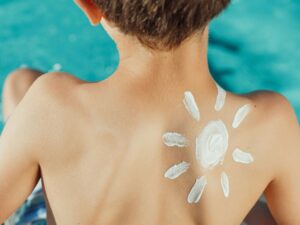Sorting Facts from Fiction for Skin Protection

In the realm of skincare, few products are as universally recommended as sunscreen. Whether you’re lounging on the beach or running errands in the city, experts tout the importance of sunscreen for protecting against the harmful effects of UV radiation. However, amidst the sea of information surrounding sunscreen, myths and misconceptions abound. In this blog, we’ll debunk common myths and shed light on the facts surrounding sunscreen, emphasizing its critical role in maintaining healthy, youthful skin.
Understanding UV Radiation
Before delving into the myths and facts about sunscreen, it’s crucial to understand the nature of the threat it protects against: ultraviolet (UV) radiation. UV radiation is emitted by the sun and comes in three forms: UVA, UVB, and UVC. While UVC is absorbed by the Earth’s atmosphere and poses no risk, UVA and UVB radiation penetrate the atmosphere and can wreak havoc on our skin.
UVB rays primarily affect the outer layers of the skin and are responsible for sunburns, while UVA rays penetrate deeper into the skin, leading to premature aging and an increased risk of skin cancer. Both types of UV radiation contribute to the formation of wrinkles, dark spots, and other signs of photodamage, making protection against them essential.
Myth: I Only Need Sunscreen on Sunny Days
Fact: UV Radiation Penetrates Clouds and Windows.
One common misconception about sunscreen is that it’s only necessary on sunny days. While it’s true that UV radiation is more intense on clear, sunny days, it can still penetrate clouds and cause damage even when the sky is overcast. Additionally, UV radiation can pass through windows, exposing your skin to harm even when indoors. Therefore, it’s essential to wear sunscreen daily, regardless of the weather or whether you’re indoors or outdoors.
Myth: Sunscreen Prevents Vitamin D Absorption
Fact: You Can Get Sufficient Vitamin D While Wearing Sunscreen.
Another myth surrounding sunscreen is that it prevents the body from absorbing vitamin D, a vital nutrient for bone health and immune function. While it’s true that sunscreen can reduce the skin’s production of vitamin D, studies have shown that most people can still obtain sufficient levels of vitamin D while wearing sunscreen. Additionally, vitamin D can be obtained from dietary sources such as fortified foods and supplements, reducing the need to rely solely on sunlight for its production.
Myth: Darker Skin Tones Don’t Need Sunscreen
Fact: People of All Skin Tones Are Susceptible to Sun Damage.
There’s a common misconception that individuals with darker skin tones are immune to the effects of UV radiation and don’t need sunscreen. While it’s true that darker skin tones have more natural protection against UV damage due to higher levels of melanin, they are still susceptible to sunburns, premature aging, and skin cancer. Therefore, people of all skin tones should wear sunscreen to protect against UV radiation and maintain healthy skin.
Myth: Makeup with SPF Provides Sufficient Sun Protection
Fact: Makeup with SPF Is Not Enough on Its Own.
Many cosmetic products, such as foundations and moisturizers, contain SPF (sun protection factor) to provide added sun protection. However, relying solely on makeup with SPF may not offer sufficient protection against UV radiation. Most people don’t apply makeup thickly enough to achieve the level of SPF stated on the packaging, and they’re unlikely to reapply it throughout the day as recommended for adequate protection. Therefore, it’s essential to use dedicated sunscreen in addition to makeup with SPF for comprehensive sun protection.
Choosing the Right Sunscreen
Now that we’ve debunked some common myths about sunscreen let’s discuss how to choose the right sunscreen for your needs. When selecting a sunscreen, consider the following factors:
- SPF: Look for a broad-spectrum sunscreen with a sun protection factor (SPF) of 30 or higher to protect against both UVA and UVB radiation.
- Broad-Spectrum Protection: Ensure that the sunscreen offers broad-spectrum protection, meaning it protects against both UVA and UVB radiation.
- Water Resistance: If you’ll be swimming or sweating, choose a water-resistant sunscreen that will stay put longer.
- Skin Type: Consider your skin type and any sensitivities you may have when selecting a sunscreen. Opt for formulas that are suitable for your skin type, whether it’s oily, dry, sensitive, or acne-prone.
- Application: Apply sunscreen generously to all exposed skin, including the face, neck, ears, and hands. Reapply sunscreen every two hours or more frequently if swimming or sweating.

In conclusion, sunscreen is a vital component of a comprehensive skincare routine, protecting against the harmful effects of UV radiation and reducing the risk of sunburns, premature aging, and skin cancer. By debunking common myths and understanding the facts about sunscreen, you can make informed choices to safeguard your skin’s health and vitality. Remember to wear sunscreen daily, regardless of the weather, and choose a broad-spectrum formula with an SPF of 30 or higher for optimal protection. Your skin will thank you for it in the years to come.

